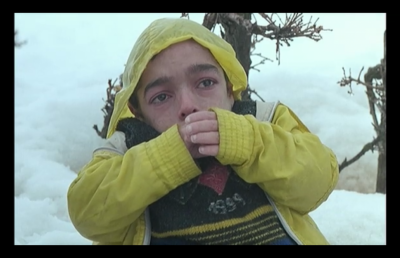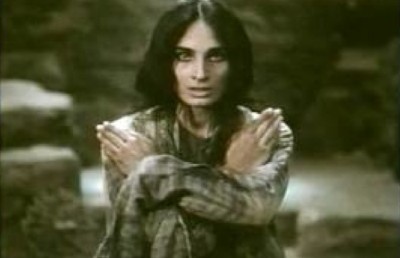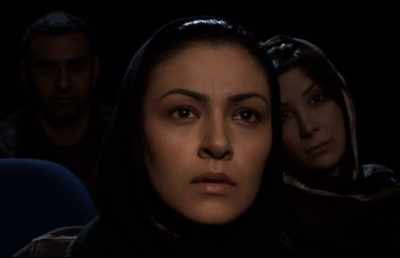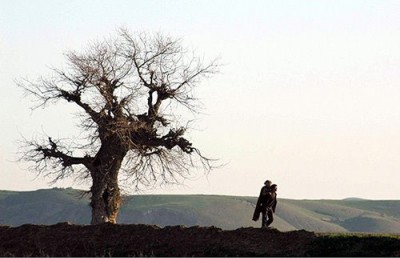Food for Thought: Sensorium of the Iranian Cinema
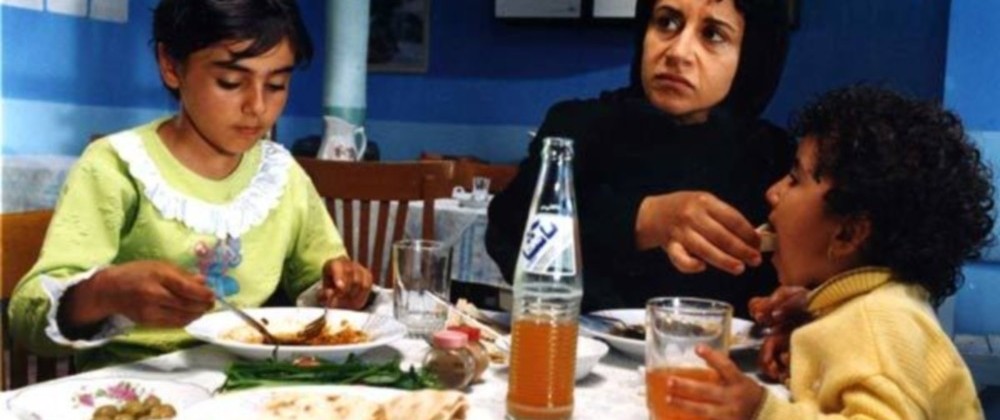
The biological imperatives of food and sex are common across species; but, intricacies of control, power and resistance associated with food and sex are human phenomena. Jane Ferry calls food a “perceptible artifact whose symbolic significance mutates with time,” “a chameleon meandering through the historical landscape changing its symbolic expression to meet the vagaries of the socio/cultural domain” (Ferry, 77). The film-food can thus represent manifold social interactions that encompass meaning, experience and action in both sensory and political realms. With food, groups touch, communicate, befriend and perpetuate culture. With food, individuals sense hunger, desire, disgust and pleasure. Unlike sex, which is webbed in religious, political and societal taboos, food transgresses the sensory into the realm of politics, uncensored. Erin Manning writes: “Sense is an event […]. An investigation of sense (making sense and/as sensation) allows us to begin to explore the manner in which the standardized discourse of the political relies on making good sense rather than on sensing […] Intelligibility need not rest on the troublesome attachment of knowledge and reason. In the end, it may be reasonable to sense” (Manning, 128). Because food operates on a universal sensorium, it creates a universal ground for empathy. Like pain, fear and gender, food materializes the politics that it signifies. Thus, it is abstract and concrete at once.
In Iran, the new shift to sensual filmmaking (as opposed to the more metaphoric transcendental form that dominated Iran’s glorious decade of the 90’s) coincides with a burgeoning neo-bourgeoisie and an all-consuming growing middle class in recent years. The volume of TV and magazine ads, the shear size and number of billboards that advertise food, skin care products, vacation packages, sports; the mushroom growth of restaurants, sports complexes, and clothing boutiques contrasts the stoic slogans of the past years of revolution and the war. A rising interest in materialist pleasure, in contrast to traditional stoic mysticism, is also shifting the political paradigms in Iran. To appeal to the massive number of the Iranian youth, artists, like politicians, have realized that it is sensible to makes sense from the senses.
Creating sensual art in Iran is a tricky business—yet one that is mastered through centuries of cultural practice. The contemporary Iranian filmmakers are strictly forbidden to express flesh (in the form of exposing skin, touching skin, romancing bodies, violating or violated bodies). They are also under tight surveillance to not undermine philosophical grounds and cultural understructures of the Islamic Republic. If they do so, they must exercise a great deal of symbolization to dress their work with multiple meaning and innumerate interpretability. In a previous Offscreen essay I have discussed the central role of women in materialization of the Iranian popular cinema. The ‘manufacturing’ of female stars, and casting them in central roles that raise questions about social and judicial women issues, has not only turned Iran’s popular cinema into a political platform to discuss social/judicial reforms, but also a large entertainment scopophilic industry. Attractive star couples have emerged. Femme fatale has become a popular theme. Romantic comedies keep breaking sales records. Action films are becoming more sophisticated. Tabloids, appearing in multitude on newsstands, discuss the on-screen chemistry and the little emotional crises of the cinema stars. The new wave of Iranian cinema has left behind the Iranian New Wave, and has substituted the metaphoric aesthetics of children and nature, with material motifs that access the more facile tastes of the average cinemagoers. Cars symbolize mobility and freedom, apartments signify dependence or independence, safety or prison, music and food substitute the sensation of romance, a way for lovers to touch. To sense has begun to make sense. Extreme long shots (e.g. in Kiarostami’s Where is Friend’s House, Through the Olive Trees) have turned to extreme close-ups on eyes, on skin (e.g. in Kiarostami’s Ten, Shirin). The words, however, remain unspoken. If there is one trend that Iranian artists of hundreds of generations have in common, it is to not use words—at least not mean them literally. Iranian art, most often dissident, is well aware that words make it vulnerable to the tyrant’s vice in the past and the censorship office in the present. To allow multiple differential interpretations, the new cinema needs to approach its political subject matter with a metaphor that is sensual enough to be visually affective. Increasingly, food, restaurants, kitchens, and dinner parties are appearing on Iran’s popular screens.
Food films provide an interesting case for sensual politics of the Iranian cinema. James R. Kelly notes that the food-cinema artist manipulates gustatory imagery in order to increase the sensory response of the film audience to a medium that cannot access smell or taste. The filmmaker thus invokes the gustatory appetite in a fashion similar to the arousal of libido through romantic or sexual imagery that allows the filmmaker to access the sensory experience of the audience (Kelly, 1). Food, similar to sex, music, reward and drugs activates the euphoria-seeking centers of the brain. Viewing food also creates a natural cerebral reaction in the pleasure centers of the brain. Food motif, therefore, gives the Iranian artist a medium for visceral communication. “Food pornography,” however, is not the sole objective of the Iranian film-foods.
Although to eat is an individualistic corporeal necessity, to share food lies at the heart of social relations. Because food is essential to life and at the heart of the economic relations, it embodies political relations. Carole M. Counihan argues that differential control over food differentiate hierarchies in class, caste, race, and gender hierarchies (Counihan, 8). Anthropologists consider food-support to characterize the relations between sexes (Counihan, 61-75). For Levi-Strauss, the dichotomy of raw and cooked food signifies human’s relation to nature and culture. Food is thus a code; eating ways are a language (Douglas, 231-234).
Iranian cinema’s flirtation with food (as the central motif of the plot) is relatively recent. Nevertheless, food has a strong cultural presence in Persian myth, folklore, spirituality and community. The purpose of this essay is to introduce the manner in which the Iranian cinema integrates the sensational relation to food with its political subject matter.
Four films will be discussed, Haji Washington (Ali Hatami, 1982), Mama’s Guest (Dariush Mehrjooi, 2003), The Fish Fall in Love (Ali Rafi’I, 2005) and Café Transit (Kambuzia Partovi, 2006). These films are notable art-house films that use food and the food-related culture to foreground their political context: national identity, social contracts, shifting philosophical paradigms and gender identity.
A Cultural BackgroundPersian culture is by and large stoic. Cyrus, the founder of the Persian Empire was greatly admired by the ancient stoic writers. [1] Persians had restrictive corporeal manners. Will Durant writes: “They thought it unbecoming to eat or to drink anything in the street, or publicly, or to spit or blow the nose. … People were abstemious in food and drink, eating only one meal per day, and drinking nothing but water … cleanliness was rated as the greatest good after life itself … angels did not come to dirty bodies … to spread infection was punishable by law … the code was stern against the sins of flesh” (Durant, 399).
Stoic residues of Persians relation to food survive in myth and in folklore:
In the Epic of Kings, Ferdowsi recounts the myth of Zohak, notorious ruler who was seduced by Ahriman (devil). Ahriman disguised as a cook and used irresistible meals to seduce Zohak. In exchange for his scrumptious recipes, Ahriman was granted to kiss Zohak’s shoulders. The two serpents grew from the kissed spots. Then, Zohak was doomed to feed the serpents the brains of the young men of the land in order to survive himself. [2] The myth of Zohak satisfies the Levi-Strauss’ structuralist claim to universality of culture. The insatiable hunger of Zohak for pleasure of food is an element of nature gone awry due to greed and absence of restraint. To lose control to nature (passion for pleasure of food) is a proxy to sin. The outcome is perpetual damnation, to an extent that Zohak becomes a slave of nature (the serpents on his shoulder) and doomed to feeding on the brain (intellect, reason and culture) of young men, in order to sustain himself. Where is this quote from?
For centuries, the relation of man to food, has encoded not only the Persians’ morale but also their politics. The Epic of Kings is the epithet of Persian resistance to Arab invasion and the Persian renaissance. The myth of (the Arab prince) Zohak eating (the Persian youth’s) brains coded the materialist interest of Arab conquerors in Persia, and survived by intellectual suppression of the Persians. In many tales of Kalila and Dimna (2nd century BC) or Rumi’s Masnavi (11th century AD) greed for food is the cause of corruption and loss, and abstinence from food a symbol of strength of character and will to deliver one through tyranny or moral difficulty.
However, Persians do not deny themselves the pleasures of food. If used in moderation, in response to nature, or as a symbol of social exchange, food can be also considered a religious entity. Proverbs such as “no faith on empty stomach,” or “the path to heart passes through stomach” acknowledge the necessity of material fulfillment prior to transcending beyond matter. In Persian folklore [3], an incurable illness will heal if one eats from an enemy’s plate. Throwing a feast, and feeding the poor keeps illness and disaster away. Bread is sacred and if dropped on the floor, it must be picked and kissed. Not finishing one’s plate is a sin. People take an oath on “the uncounted grains of rice.” If someone chokes on a food it means his relative is hungry. Food is a medicine: grapes and nuts add to intelligence. Fig, date, olive, pomegranate, apple are fruits from heaven. Apple and pear make the pregnant woman’s baby beautiful.
Persians, shy and stoic with sexual pleasure, have amusing epithets of love such as “eating the beloved’s liver,” or “drinking the beloved’s lips,” instead of cuddling and kissing. As Farzaneh Milani notes, Persian language describes “Moon-faced beauties [with] almond-shaped eyes, peachy complexions, pistachio-like mouths, jujube colored lips, hazelnut-like noses, red apple cheeks, and lemon- or pomegranate-like breasts-a mobile green grocery” (Milani, 187).
Food is an essential component of social relations in Iran. Treatise written in 1671 to describe proper manners for Shiite Iranians devoted a significant attention to table manners and food. [4] Central to Persian good manners and politeness is to avoid hurting other people’s feelings. Food, no matter how little, must be shared. A beggar soliciting food must be fed. Enemy must not be denied food and water. A guest must start eating as soon as bread is on the table, to spare the host embarrassment in case he does not have more to offer. Food is offered in abundance in weddings, funerals, religious ceremonies, and prayers. Persians, especially the more traditional Iranians, treat food in a very socialist manner: it aggregates communities, defines them as a unity.
As these examples show, using food to describe the relation between will, faith, and “stomach” (literally), creates fleshly boundaries that delineate several aspects of the Persian culture and bind politics (how to come together) and philosophy (how to make sense) to corporeality (how to satisfy the body).
In such a gourmand culture, where the tyrant eats the brain of the suppressed, where the lover eats the liver of the beloved, where the faith depends on filled stomachs, where the enemy is safe as long as he sits at your table, and one heals if he eats from an enemy’s hand, it is logical that cinema use edibles to describe social relations, to discuss politics or to tell love stories.
Haji Washington: Cultural IdentityHaji Washington (1982, Ali Hatami, not screened until 1998) is the tale of the adventures of Haji Hossein Gholi Khan (Haji), the first Iranian ambassador in U.S.A. during the reign of the Qajar king Mozaffaradin Shah. Haji Washington is the tale of alienation of an eastern man meeting the western hemisphere; it is a historical criticism of the Qajar’s encounter with modernity. Hatami’s sets are detailed, his dialogues elaborate and spoken with the grammar of the 19th century; thus hard to understand for the average cinemagoers. Nevertheless, the motif of food in this film creates a satirical atmosphere that clarifies the political message of the film.
The film targets the inaptitude of the Iranian politicians, both in ruling over their own populace, and in connecting to the world at large. The film begins as the herald of the king calls people to gather to bid farewell to Iran’s ambassador who is on his way to America. The message threatens those who would not attend to punishment by whipping. Haji sets on the road after this staged farewell ceremony. For the rest of the film we hear Haji’s diary as he speaks on camera, while living his experiences. He begins by expressing dismay about his national obscurity in Europe: “although the kings has ambassadors in all European countries, people gave odd looks at my attire. It sadly seems that all Iranian envoys change into Western dress as soon as they cross the border from Iran.”
The stark contrast between Haji’s culture in the American society is prominently highlighted in relation to the manners of eating. As he strolls in a park under the wine shrubs, looking at the Brookline Bridge, Haji eats grapes from the wines, his aristocratic hands locked together behind him, as if the grape is held for him by a servant’s hand. Hatami juxtaposes this image with the image of an American woman who delicately picks one grape and puts it in her mouth. This contrasting manner of eating is repeated in a later sequence when Haji is sitting on the floor, eating a traditional Iranian food with his hands, while his westernized translator and butler sits at a table next to Haji.
However, in a later sequence, food also becomes a way of creating a common interest. In his first meeting with his American counterpart, he offers him pistachios to demarcate their diplomatic friendship. Later on, when he meets the president of the United States, and delivers his highly dramatic speech, at which the president stares in utter discomfort, without understanding a word or deciphering a single gesture. Afterwards, Haji breaks the “diplomatic” ice by offering a handful of pistachios. He tips his servants and his mailman with pistachio. Towards the end of the film, the President (who is no longer in the office) visits him asking for more pistachios as he intends to start farming it in his Texas ranch!
Food is also used to prop a political statement. A particularly poignant sequence is when Haji (who is in financial duress and lonely) slaughters a sheep (which he has been keeping in his bath tub) on the terrace of his mansion. To sacrifice a sheep and distribute its meat amongst the poor is an Islamic tradition. As Haji skins the sheep hanging, he speaks angrily of the futility of his mission, the incompetence of the Qajars, acknowledging his own complicity: “I spent a fortune to keep up the appearance abroad. What use? What appearance? It would have been more useful if they built an orphanage. They import wine from France; but there is famine there is epidemic outbreaks in the country [Iran]…”. The anger with which he chops the meat off the carcass, the splashed blood on his face and the exposed flesh of the dead sheep on its way to someone’s dinner creates one of the most visceral reactions to the food theme that matches the outrage felt by Haji’s critique of the Qajar’s unjust governance.
In many ways, this film mocks the omnipresence of food in the ambassador’s diplomacy, and reduces his political purpose to a food salesman and the facile consumer of pleasurables. The only official visit he receives is from the President “after” he is kicked out of office. Even then, the President’s only interest is in pistachio, which he hopes to farm in Texas! On the other hand, Haji, who does not even read newspapers, and is unaware that the visit is not a state-function, dresses in his official attire while acting like an inferior servant who lacks any diplomatic skill other than entertaining with food. The scene of Haji sitting on the floor breaking the sugar cone, making the tea, or chopping the meat implies the ambassador’s sense of inferiority. Haji’s zeal to impress the president brings to fore another critique of the Qajars superficial foreign policies that were more invested in keeping up the appearance rather than keeping up the Iranian interests. The five minute shot of Haji listing the edibles offered to Mr. President becomes increasingly irritating, as he moves from list of rices to stews to jams and drinks. Haji’s meticulous attention to food items while he fails to keep up to date with the news is an embarrassing encounter with the history of the Quajar dynasty.
Haji Washington uses food to tell both the story of a man in an alien society, and a national identity alienated by inability to communicate. For its time, Haji Washington was an avant-garde film. Even to date, now that the Iranian cinemagoers have become accustomed to non-representative, elliptical and non-linear cinematic narration, the film is not accessible. Nevertheless, the motif of food, and the culture that surrounds it anchors the political theme of this film. At the end, the westernized translator/butler lets Haji have it: “You are useless, your only purpose is to bring wine back to the king, get out of here and carry your wine load.” The only thing that the Qajars were capable of was to pay attention to the stomach!
Mama’s Guest: social contractMama’s Guest (Mehman-e Maman, 2004, Daryush Mehrjooi) is a social comedy and it is directed by one of the most prominent Iranian directors. Mama’s Guest is a satirical examination of social relationships in Iran. Similarly to Haji Washington, it questions the vitality of “aberoo,” or “keeping up appearances” in the Persian culture, which is directly linked to the practices of food offering. However, it also presents the empowering aspects of this culture and reflects its importance in binding communities together and helping them overcome hurdles.
Mama’s Guest is the adventures of a woman whose pocket is not deep but her pride is tall, and wishes to impress his newly wed nephew and his wife with a kingly dinner. Mum has two children and a “cinematic” husband who works as a projectionist in a bankrupt cinema. The husband is childish and inconsiderate of his wife’s financial limitation and he invites her nephew and his wife to dinner. Learning that Mum’s cupboard is empty, the neighbors, a cast of eccentric characters (Mash-Zeynab, a gypsy who keeps chickens as pets; Yusef, a drug addict and his pregnant wife, Sedighe; a chemistry student who thinks he is a genius, Mr. Dr.), come to her rescue. Everyone tries to be discrete and to hide the reality of Mum’s poverty from the guests. Neighbors are equally poor, but they realized the uncompromiseable importance of “aberoo.” As a result, they envision creative ways (such as chasing the neighbor’s chicken around the yard, emptying the fridge of the addict man’s rich parents, sneaking to a meat store and ‘borrowing’ fish and chicken, and pooling together everything anyone can find in their house) to make a colorful dinner. In spite of the odds, the dinner turns into a feast for the entire neighborhood.
In an interview with the Iranian Film Monthly, Mehrjooi expressed that he wanted to make a film about communities and represent the daily concerns of the Iranian mothers who have to juggle the material realities within complex cultural and social codes. [5] Mehrjooi admitted to worrying that depiction of a below-poverty community might not have been successful at the box office at a time when the colorful neo-bourgeois films dominated the atmosphere of the current Iranian cinema. However, the film was met with both critical and popular success.
Mama’s Guest is Mehrjooi’s first food-film, but food is an important motif in most of his earlier films. [6] Mehrjooi does not consider food as a prop to evoke any physiological response in his audience. Rather, he uses eating to portray daily routine and highlight certain rituals and cultural habits that provide a context for human interactions. “Sufra” (table) for Mehrjooi creates the core of the family. [7]
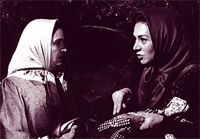
In Mama’s Guest, the chaos and the excitement of preparing the dinner creates multiple layers of meaning that cover a range of topics such as gender roles, societal contracts, cultural dysfunction, love and respect, cooperation and altruism, poverty and desperation, even spirituality. In addition, the visceral reaction to images of tasty food are paradoxically countered with an intellectual repulsion raised by grasping the depth of the material poverty of the characters of the film. In spite of the joy felt by the characters while making and eating the food, Mama’s Guest operates within a stoic frame of reference.
In the sequence where a chicken is chased to sacrifice for the guests, Mehrjooi makes his stoic intentions known. One of the first solutions to Mum’s dinner dilemma is to ask her gypsy neighbor (Mash-Zeinab) to give up one of her chickens. Mash-Zeinab has lost all of her children to war and has moved to the city and her chickens are her children. When asked for one, she starts a tantrum, saying it would be impossible for her to give up her chickens, but at the end Sedigheh (the pregnant wife of the drug addict) convinces her that “aberoo” is more important than her love for a chicken. Then the process of selection begins. Mash-Zeinab talks to her chickens one by one, praises them and scolds them, picks one that she begrudges but bursts into crying remembering her memories and picks another chicken and so on. At the end, she decides to give up her rooster. She gives it a tearful kiss and says goodbye. In the next shot, we see the rooster being prepared for slaughter, and before the blade reaches its throat, Mash-zeinab breaks into hysteria and saves her rooster. Although farcical on the surface, this sequence creates a viscerally uncomfortable reaction. It calls to question the relation of man to nature and to other species. In some ways, the critique expressed in this scene invokes the dichotomous relation of man’s stomach to nature and culture. It is the culture that demands a chicken be served to the guests, it is not a necessity of the nature. However, it is the nature that is to be sacrificed: both the chicken’s life and the feelings of Mash-Zeynab are more “sensually” palpable than the cultural necessity of a roasted chicken—the emblem of aberoo! The sequence ends happily as the stoicism triumphs and the women decide that impressing guests, and satisfying an appetite for meat does not justify Mash-Zeinab’s misery, thus the rooster lives!
In Mehrjooi’s film, the function of food is not to satisfy the body, but to satisfy the soul. The butcher beats up his son when he realizes he is stealing food for his friend, Mum’s son. However, when he learns that the purpose of stealing was to keep Mum’s aberoo, he volunteers several bags full of meat. Yusef empties the freezer in his rich parent’s mansion in order to keep up Mum’s aberoo, but he refuses his father’s offer of help to him and his child—even though he is dreadfully poor and his wife has thrown his expensive drug supplies away. In response to his father’s offerings, Yusef tells them that he is shelling walnuts [8], and is making money with his own hands and he is not taking the meat for himself but to feed the neighbor’s guests. The attitude towards food signifies a cultural need, a moral obligation to the society, and not to one’s own biological or financial needs.
Not only is Yusef altruistic about food, but he also uses food as a political tool. Yusef rejects his mother’s sandwich as a sign of defiance showing his determination to keep his marriage independent. By refusing food from his mother, he punishes her for opposing to his marriage. Yusef makes a political statement by taking food for strangers who are in need of satisfying a social obligation, but by denying his parents the pleasure of satisfying his corporeal pleasure. Yusef’s act symbolizes a stoicism that is uncharacteristic of a drug addict, and furthers the paradoxical anti-pleasure subtext of the film.
However, in most respect, Mama’s Guest is festive; the dishes are prepared gloriously; there is a lot of boiling and broiling of delicious ingredients, but in the end this is not an appetizing film. The subtext of poverty prevents a visceral response to the pleasure of watching scrumptious food. The fact that Mum’s children have never seen shrimp, that fish is a rarity in that neighborhood and that Mum will not have anything to feed her guests another day creates another degree of anti-pleasure.
Despite the bleak subtext, the film does not leave the viewers unhappy. First, it depicts women (of all generations) in position of power—the ideal scenario of feminism-loving intellectuals. Secondly, the film provides prescription for overcoming oddities with a spirit of cooperation and unity. At the end, cooperation triumphs and the film feeds all the neighborhood—even the construction workers of the adjacent building. Third, the film juxtaposes the warmth in the poor apartment complex to the chill of the wealthy mansion of the upper town. Therefore, it prescribes a spiritual formula for happiness that is independent of insatiable material needs. Mama’s Guest uses the motif of food to unsettle its viewer’s visceral relation to food to inspire them politically and philosophically.
The Fish Fall in Love: Sense and SensibilityThe Fish Fall in Love (Mahi-ha Aashegh Mishavand, 2005, Ali Rafi’i) resembles Mama’s Guest as it too has a central neurotic mother figure, who is in charge of a complex food preparation operation. However, this film’s approach to life and society is more epicurean than stoic. This is the first feature film of the theatre director Ali Raffi’i. Similar to Mama’s Guest and Haji Washington, the film happens in the conjuncture of reality and fairy tale. It is about lovers who were (and are to be) separated by prison, and the inter-generational gap in emotional perception, expression and philosophical perspective on life.
The Fish Fall in Love happens in warm colors of red, blue, orange, yellow, against the lush green of the Caspian coast in Iran. It is decidedly a sensual film and anchors emotions to food. In an interview with the Iranian newspaper Aftab, Ali Rafii speaks about the influence of Marx’s early writings on the coupling between emotions and pleasure of eating. An assistant to Agnes Varda and a student in Paris during 1968, it is not surprising that Rafii tells the story of an ex-Marxist with an impressionist sensuality that is characteristic of the French New Wave.
The Fish Fall in Love does not dependent much on narrative. Instead, the stories are a canvas on which Rafii paints the colors of food, nature and love. The story is that of an Iranian émigré, Aziz, who returns to Iran and finds his house turned into a busy restaurant by his old lover Atiyeh. The film begins in a road restaurant, where Aziz meets Reza, a Tehrani student who works in a fish-farm and who talks to Aziz about the cultured fish versus wild fish. Reza looks like a political activist and talks like one. The political metaphors are also food-related: the wild fish that swim against the river are more delicious tender than the farmed fish. Suddenly, Reza gets arrested, reminding Aziz of his own youth: going to prison for his political beliefs and losing Atiyeh, his love.
Atiyeh (widowed with one child) is a strong but neurotic character, who treats her restaurant business seriously: “People who leave this restaurant need to have their stomachs filled and their souls satisfied,” she says repeatedly. The return of Aziz augments Atyieh anxiety. Not only has she not forgotten their love, but she also has not forgiven Aziz for disappearing. Besides, she fears that Aziz is back to reclaim and sell the house and return abroad.
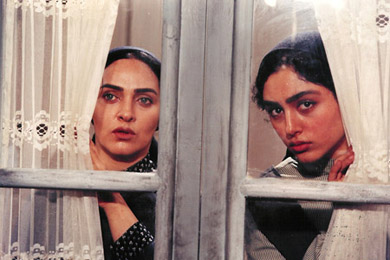
The unsettling anxiety about Aziz’s intentions inspires Tukah, Atieh’s daughter, to pre-empt the tension between her mother and Aziz by using the artillery of delicious food and “making Aziz a part of the family.” After many cuts between scrumptious dishes, chopping, boiling and broiling, at last the old flame gets rekindled. Aziz’s has a bottomless appetite for Atiyeh’s food, and his life philosophy revolves around the emotional importance of gathering around a meal.
Rafii binds emotions to food. Aziz and Atiyeh get back together when she brings him his dinner for the first time. The intimacy between the couple is abstracted in aerial shots of them roaming in the market, picking red tomatoes, filling their basket with cucumbers and eggplants, negotiating the price of fish, eating and cooking together, playing in the orchards, having a candle-light supper.
For Atiyeh, the imperatives of running the restaurant are so emotional that the threat of losing the restaurant endangers her life (she suffers a stroke). When she recovers from her stroke, the joyous expression of her customers revitalizes her. Besides filming close-ups of the dishes, director Rafii also spends ample footage capturing the emotional exchanges between people tasting the food. In contrast to expressionist and theatrical acting of the main character, the satisfaction on the customers (most probably non-professional actors and extras) facial expressions effectively communicates the emotional pleasure of eating.
In The Fish Fall in Love, no one is a victim, and nothing is criticized. The purpose of life is to bring happiness to others. The young characters of Tukah and Reza have no ideological aspirations. They just want to be in love and to make a living (we later learn that Reza was not imprisoned for his politics but for smuggling drugs in order to provide for their upcoming wedding). The older characters, Atiyeh and Aziz have come to realization that to live, to love, to enjoy nature, and to provide happiness (rather than fighting unhappiness) is the purpose of their lives. This film wants to give pleasure, and it successfully does so. If one accounts for the mushroom growth of the restaurant and food industry in Iran, then the epicurean intentions of Rafii resonate well with the current taste of the society.
Café Transit: Gender & IndependenceCafé Transit (2005, Kambozia Partovi) is similar to The Fish Fall in Love as it too uses food as a medium for communication of feelings, as well as an economic tool in service of women’s independence. In an online interview from “Cinema Without Borders,” Partovi stated that he “…wanted to consider the situation of some Iranian women, in pretext of food and cooking, which is considered as a part of a community’s culture and exhibits its living style and its economical conditions.” [9] Café Transit, however, is not a fairy tale. It is a very realistic depiction of the social reality of women’s lives and their triumphant achievements in a patriarchic society.
Café Transit tells the powerful story of a newly widowed young woman, Rehyan, who refuses to succumb to the local tradition of marrying his brother in law. The tradition troubles Rehyan because she doesn’t love the man, the man is married, and this peculiar custom is not a part of her traditional values. Rehyan defies the rules of the tribe by reopening her late husband’s border cafe. Rehyan’s unmovable decision to be independent creates intense conflicts with her late husband’s brother whose ego is hurt by Rehyan’s rejection, as well as by the fact that Rehyan’s café sidelines his restaurant.
One of the main functions of food in Café Transit is to establish the gender boundaries within which Rehyan can thrive. When the brother-in-law threatens her with an official injunction to shut down the business, Reyhan confronts the male ego with a cool response: “I do not go out to serve the customers; I am just the cook. If cooking is a sin then I will stop.” At the end, Rehyan’s kitchen skills end the control-war in her favour. The film uses frequent close-ups on what is cooking in the pot to illustrate Rehyan’s culinary mastery: saffron rice, pomegranate sauce, breaking eggs on frying tomatoes, steamy stews, fresh herbs, colourful table, happy customers, joyful music, warm blue color of the walls. Her small cafe over-shadows the brother-in-law’s restaurant and grants her the financial independence to defy the traditional rules of the village and to remain socially independent.
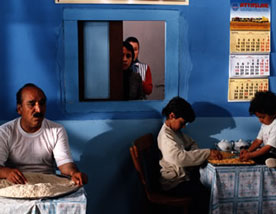
The kitchen of Café Transit serves as an important symbolism. Rehyan earning money from cooking is an economic reality but it also a symbolic act. Cooking signifies Rehyan’s gendered identity. The kitchen is Rehyan’s sanctuary. Men are not allowed in her kitchen. She can break the law in her kitchen and hide a refugee girl for as long as she wants. She cannot kick her persistent brother in law out of her house, but she can kick him out of her kitchen. The food and the kitchen are her turf, her territory; and neither the law, nor the traditional rules can violate the boundaries of her kitchen. If the boundaries of the kitchen are changed or violated, Rehyan’s independence will become vulnerable.
Although Rehyan’s boundaries seem limited to kitchen walls, the feminine touch of her food is not concealed from the costumers—mostly the transit drivers crossing the North-Western borders of Iran to Europe. Rehyan uses her cooking skills to touch one particular customer, a Greek driver (Zakharia) who refuses to eat the Café food at first. His melancholy, and his odd refusal to eat the food (and perhaps his great looks) intrigue Rehyan. To connect with him, she tries to recreate the recipe of the canned food that Zakharia eats. Rehyan’s desire to attract the attention of this man is palpable in the enthusiasm she exhibits when she cooks in the solitude of her kitchen. Rehyan’s gustatory seduction works. Zakharia’s nostalgia finds the flavours of his lost love in the flames of Rehyan’s cooking. Rehyan and Zakharia cannot speak to each other. There are the cultural boundaries that prohibit Rehyan from associating with a stranger man; there is also the language barrier. They cannot communicate but through the culinary. Food is their romantic bond.
Preparing food together also provides a context for friendship. In a powerful sequence, Rehyan speaks to a Russian girl—who listens to a language she doesn’t understand, as attentively as she peels vegetables. The film then cuts to reverse the roles: the Russian girl speaks to Rehyan as she peels potatoes. It is an intimate moment between two women who have in common a private pain of loneliness, and their womanhood. The only time that Rehyan engages in an intimate conversation with a woman from the community, they are baking bread together. When Zakharia is spotted peeling vegetables—an indication that he has found a place inside Rehyan’s culinary castle—the chauvinist brother in laws find the perfect excuse to beat Zakharia and to close up her restaurant.
Rehyan’s cooking also transports her beyond the boundaries of her geographical space. Her story travels with her recipes as Zakharia and the Russian girl tell her story to their companions. The Russian girl seems to be running a similar operation elsewhere, while she flashes back to the story of Rehyan, and recounts her experience as she feeds Rehyan’s recipes to her customers. In other words, food provides a way for strangers to make sense of each other’s lives. Learning differences in taste aid characters to accept each other’s differences and learn to appreciate new tastes. At the end of the film, one comes to realize that Rehyan’s experience is one of empowerment and not defeat. Café Transit, thus, expresses a new form of feminist view that capitalizes on the power woman hold based on their differences, and not likeness to men.
ConclusionThe discipline of films studies has recently begun to offer an impetus for undertaking a psychoanalytical, historical, anthropological and linguistic interest in film. Books such as Jane Ferry’s Food in Film (2003), James Keller’s Food, Film and Culture (2003) and Anne Bowler’s Reel Food (2004), a collection of essays on food and film, illustrate that images of culinary in film deserve a closer attention as they signify subtextual meanings that relate to myth, culture, identity, race and most importantly (and least noticed) body. In this essay I have attempted to illustrate that food provides a universal sign that allows transcultural communication. In Haji Washington, food and manners of food consumption highlight the cultural isolation. In Mama’s Guest, preparation of food signifies the paradoxical nature of social relations in Iran. In The Fish Fall in Love, food gives the artist the pallet to create an impressionist image of life and happiness. In the Café Transit, food delineates the gender boundaries of social participation. Because of the nature of our sensory system, images of food can create strong visceral sensations ranging from euphoria to disgust. ??Haji Washington??’s slaughtered sheep and Mash-Zeinab’s to-be-slaughtered rooster unsettle us into disgust; Atiyeh’s colourful cuisine and Rehyan’s affectionate dishes reward us with pleasure. The unsettling food images lend to the films a critical politics, the pleasing ones contribute to politics of hope. Food offers a rich flavour to film because it connects our nature to our culture, and in doing so ties together different aspects of our humanity.
BibliographyBower, Anne L, Ed. (2004) Reel food : Essays on Food and Film, New York, Routledge.
Counihan, Carole M.(1999) The Anthropology of Food and Body: Gender, Meaning, and Power, London, New York: Routledge.
Douglas, Mary, (1999) Implicit Meanings: Selected Essays in Anthropology, London, New York: Routledge.
Durant, Will (1954) The Story of Civilization: Part I, Our Oriental Heritage, New York: Simon & Schuster.
Ferry, Jane F. (2003) Food in Film: A Culinary Performance of Communication, London, New York: Routledge.
Keller, James R. (2006) Food, Film and Culture: A Genre Study, Jefferson, NC, London: McFarland & Co. Inc.
Manning, Erin (2006) Politics of Touch, Sense, Movement, Sovereignty, Minneapolis: University of Minnesota Press.
Milani, Farzaneh (1992), Veils and Words, the Emerging Voices of Iranian Women Writers, Syracuse, New York: Syracuse University Press.
Persian Sources:
Ferdowsi, Shahnameh, Online version.
Ed. Ghareh-Sheykhlu A., Vafayee M, Daryush Mehrjooi, critiques from Banoo to Mama’s Guest, ISBN 964-363-279-2.
Hedayat, Sadegh: Encyclopedia of Iranian folklore, ISBN 964-5571-16-2
Mehdi Azar Yazdi: New stories from old books, ISBN 964-90025-4-5
Aftab Daily via gooya:
Endnotes
1 J. Rufus Fears, “Cyrus as a Stoic Exemplum of the Just Monarch”, The American Journal of Philology, Vol. 95, No. 3. (Autumn, 1974), pp. 265-267.
2 A translation of Zohak’s story is available here.
3 Examples are taken from Sadegh Hedayat’s “Farhang-e Amyaneh-e Mardom-e Iran” (the folklores of Iran),
4 H.E. Chehabi, “The Westernization of Iranian Culinary Culture”, Iranian Studies, volume 36,number 1, March 2003.
5 Majaleh Film, no 322.
6 Colorful dishes in mailman, religious stew in Hamoun, the BBQ in the Tenants, the great cook who stole from Banoo.
7 (p 198, my translation)
8 Fresh walnut has a green skin with a strong colorant used to make natural dye for carpet threads. At the opening scene of the film, we see Yusef sitting on the ground cracking walnut shells, his hands all dyed in black. Fresh walnuts are sold by unit in Iran and Yusef indicates that he sells 600 units per week to support his wife.



